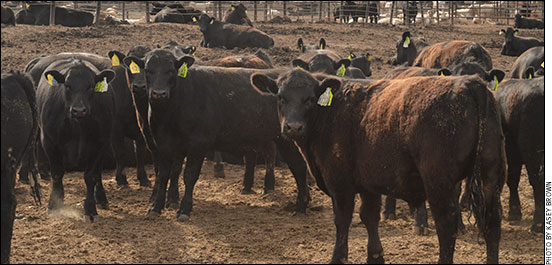HEALTH & NUTRITION...

A Search for BRD Solutions
New research finds protein vulnerability to BRD; developing test.
BRD (bovine respiratory disease) costs the beef industry more than any other single disease in death losses and treatment costs. Studies have shown that at least $500 million are spent each year on drugs and vaccines that alleviate only part of the problem.
According to Steve Carlson, veterinarian and researcher at Iowa State University and scientist at AeroGenics LLC, “BRD frequently occurs when calves are transported from ranch of origin to the feedlot. This disease is seen in 10% of the 3 million calves transported each year, and about 40% of those affected calves perish,” he says.
Read more.
Risk Increased For Hardware Disease, Blackleg
Tornadoes can blow storm debris into pastures, and flooding stirs up the soilborne bacterium causing blackleg.
Livestock owners need to scan their pastures for storm debris that could prove fatal to their cattle, goats and horses, said Tom Troxel, associate department head of animal science for the University of Arkansas System Division of Agriculture. After the storm has passed, the effects of tornadic winds and floods remain for grazing animals.
“Tornadoes and other storm events with strong winds and flooding can spread debris over a large area,” Troxel said. “This sets the stage for grazing animals to be affected by ‘hardware disease.’ ” Read more.
Feed Cattle, Not Parasites
Consider five simple steps to fight parasites this spring.
Planning for parasite protection should be top-of-mind for cow-calf producers before branding and spring turnout each year. Parasites can leave a path of destruction in any herd, but controlling them is as simple as knowing a few key tips. Read more.

Rick Rasby
Ridin’ Herd
Weaning beef calves early.
In areas where forage quantity is not adequate for spring, summer and early-fall grazing, early-weaning could be a management practice to consider, especially for young cows raising their first calf. It may also be a management strategy to consider during drought when forage quantity is reduced due to weather conditions. Increases in grain price and the subsequent impact on land values and lease rates have challenged the long-term availability of forage for summer grazing. Recent drought conditions have decreased forage production and diminished rangeland carrying capacity in certain areas. Read more.
Summer Pneumonia in Calves
Study is searching for answers about summer pneumonia.
Pneumonia (infection in the lungs) can affect calves of any age. Most of the bacterial pathogens that cause pneumonia are already present in the calf’s upper respiratory tract. They become a problem in the lungs only when the calf’s immune defenses are compromised, such as by viral infections or stress. Stress may be due to bad weather; extreme changes in temperature; a long truck haul; overcrowding in a dirty environment; or nutritional stress due to deficiencies of an important mineral, such as copper or selenium.One of the most frustrating respiratory infections in nursing calves has been called “summer pneumonia.” The cause is not always easy to determine — especially since cases tend to appear during good conditions when we don’t think of these calves as being stressed. Read more.
Anthrax Update
Anthrax may appear in summer after spring flooding.
Anthrax can infect all warm-blooded animals. Charles Stoltenow, North Dakota State University Extension assistant director and program leader for agriculture and natural resources, says that because of human risks, anthrax is a reportable disease. Cases of anthrax in livestock must be reported to the state veterinarian.
The bacterial spores can lie dormant in the ground for 50-100 years or more, enabling the disease to crop up again.
“The vaccine is very effective and inexpensive. If you live in an area where anthrax has occurred in the past, it’s wise to vaccinate cattle ahead of when you plan to turn them out on pasture,” he says. Read more.
Take Steps to Keep Horses Healthy
K-State veterinarian says equine herpesvirus myeloencephalopathy occurrence is a reminder to take precautions.
It’s springtime. For many horse enthusiasts that means heading out to horse shows and rodeos. Two recent cases of equine herpesvirus myeloencephalopathy (EHM) discovered after a barrel-racing event in Nebraska should serve as a reminder that good biosecurity practices can help prevent illnesses, said a Kansas State University (K-State) veterinarian. Read more.
Cattle Diseases: Common Conditions/Terms
Click here for a list of common conditions and terms related to beef cattle diseases, such as anaplasmosis, brucellosis, BVD, E. coli, IBR and others.
[Click here to go to the top of the page.]





